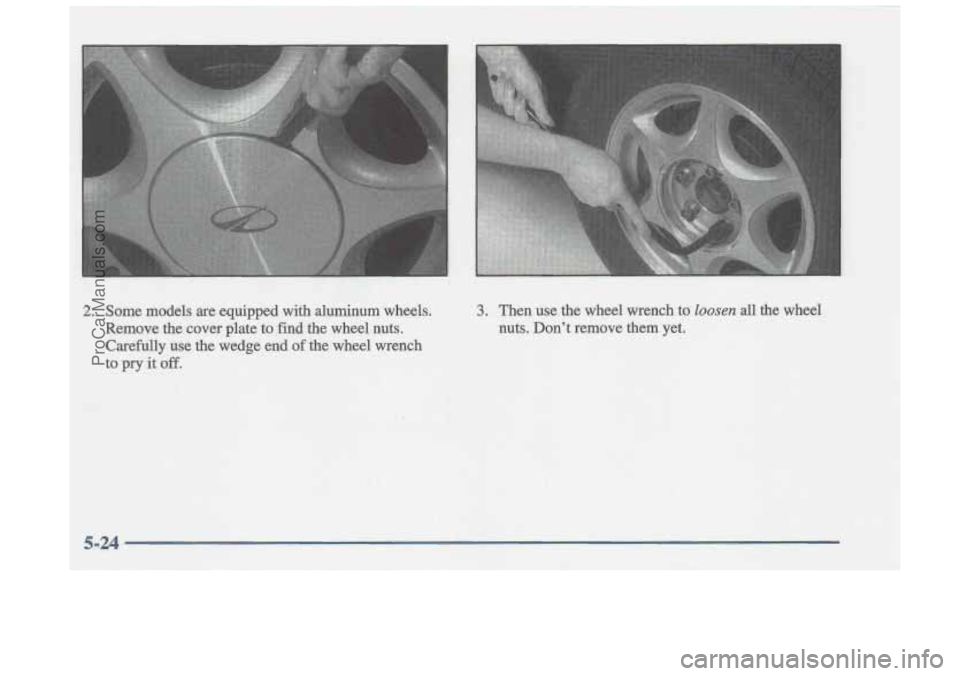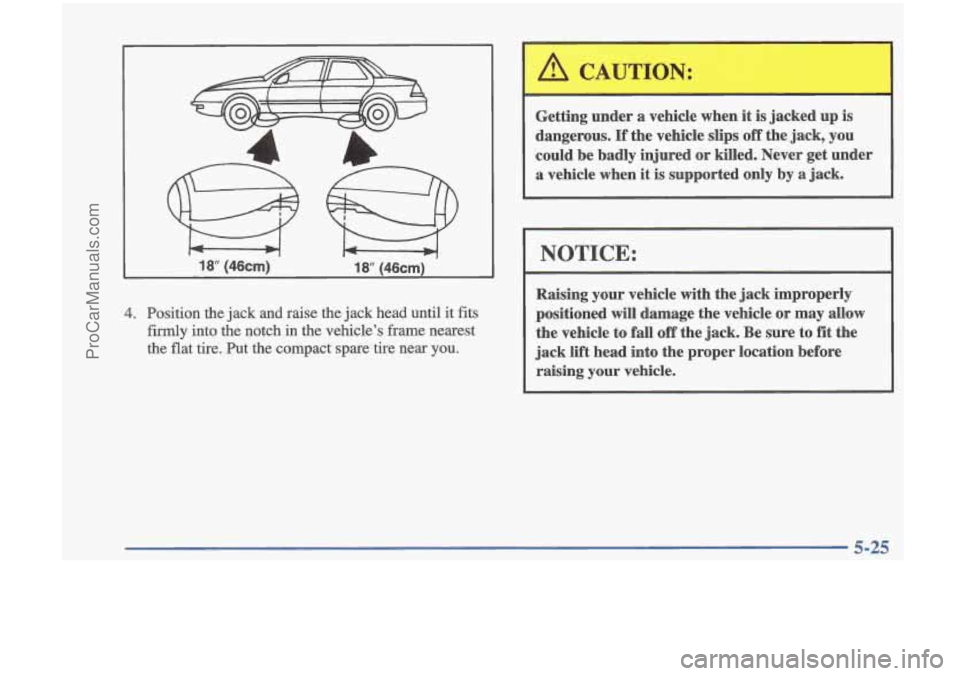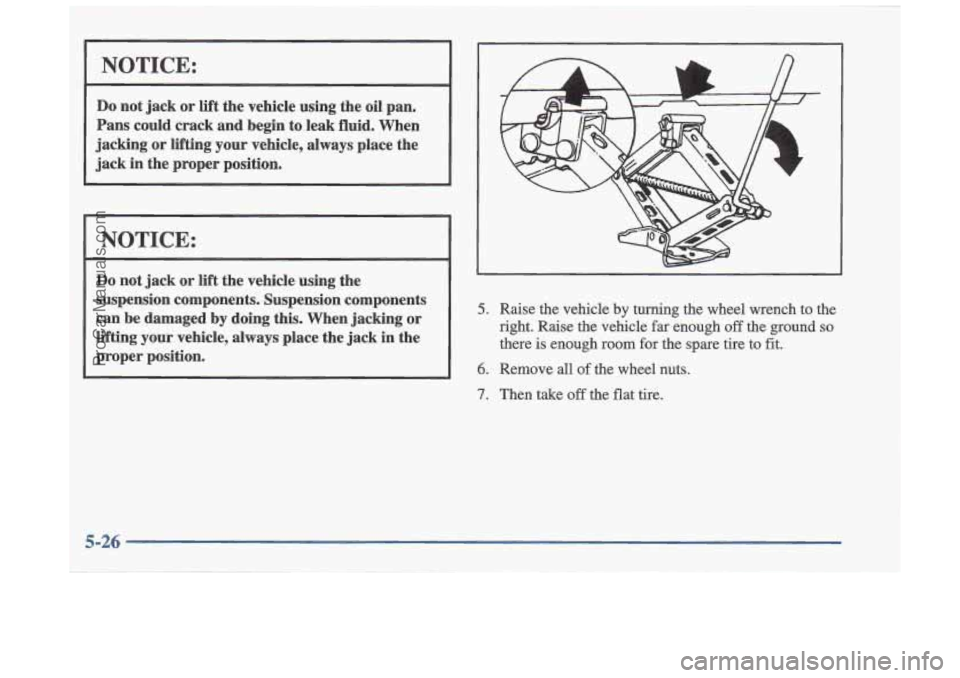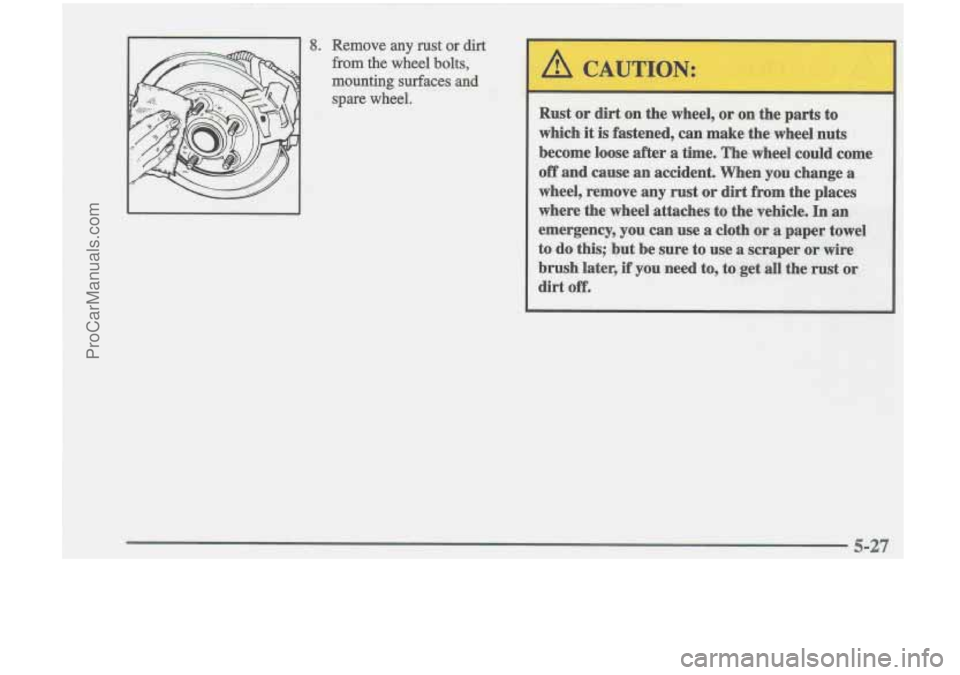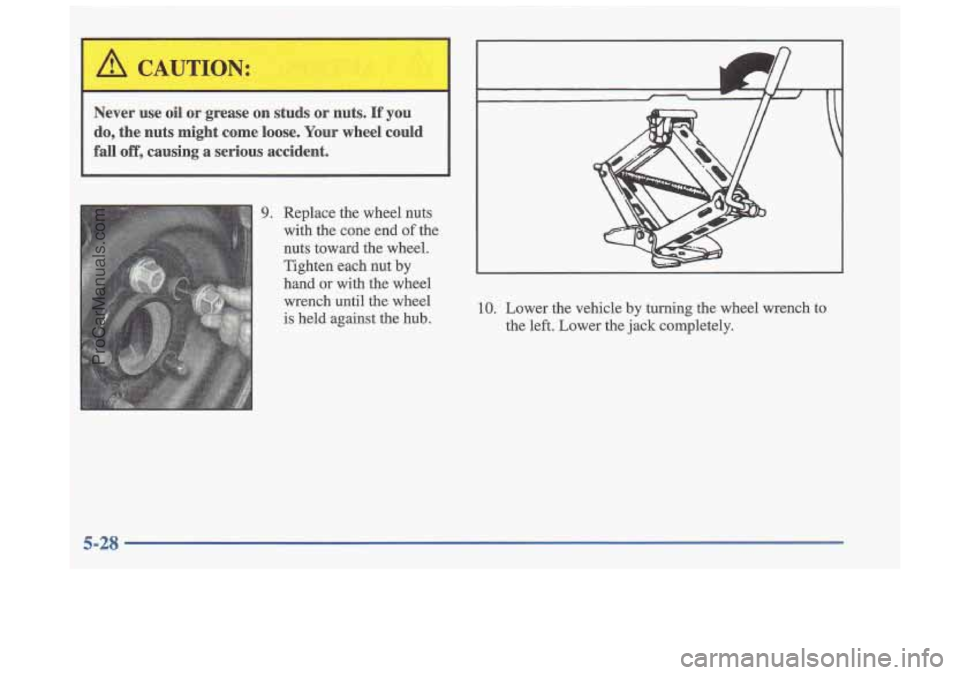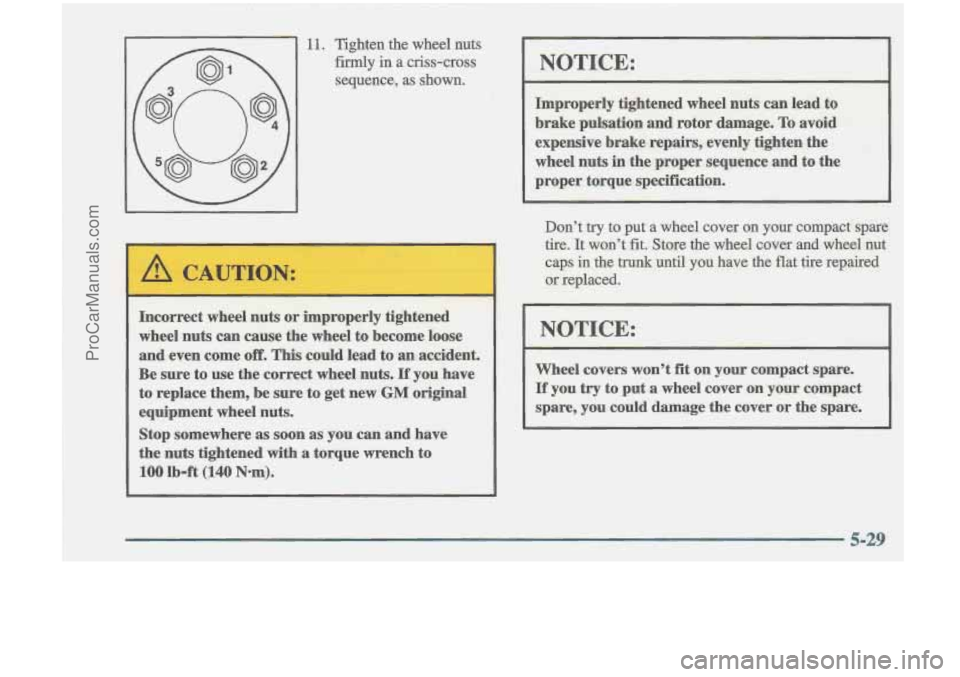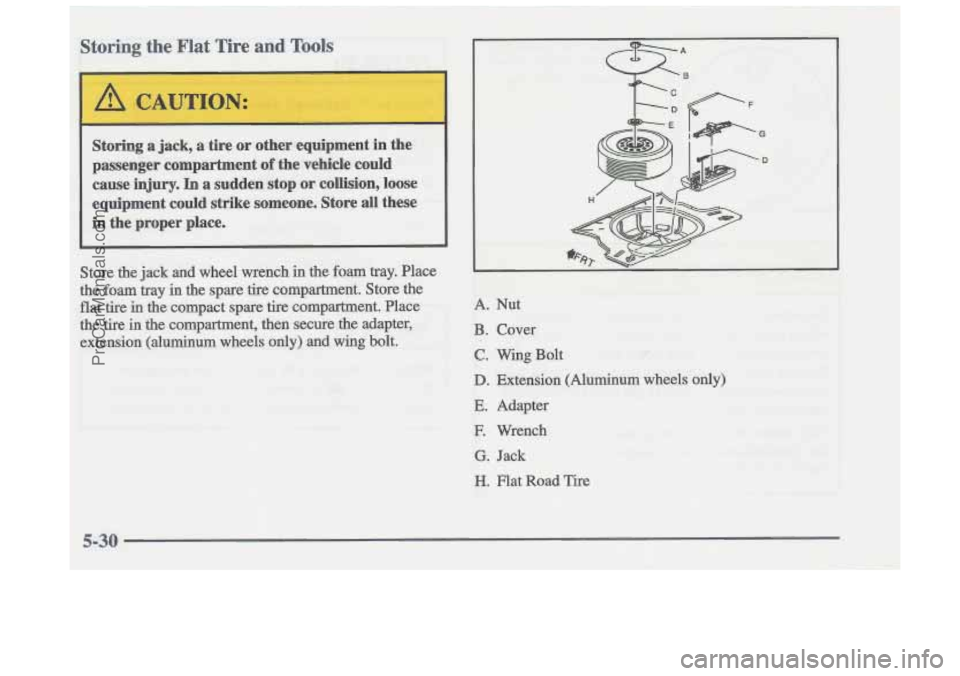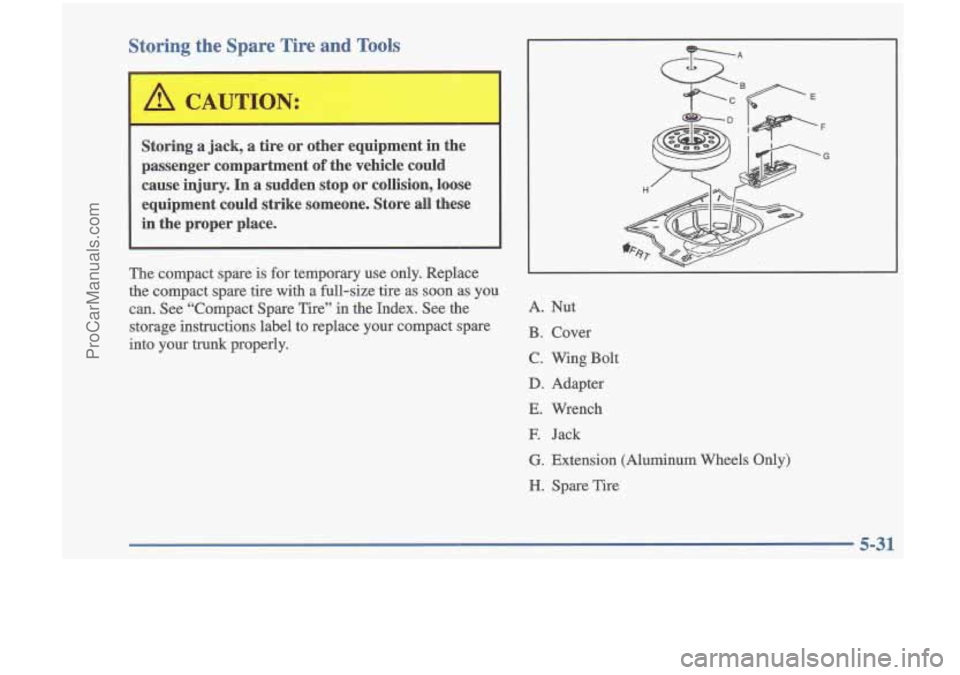OLDSMOBILE CUTLASS 1997 Owners Manual
CUTLASS 1997
OLDSMOBILE
OLDSMOBILE
https://www.carmanualsonline.info/img/31/58202/w960_58202-0.png
OLDSMOBILE CUTLASS 1997 Owners Manual
Trending: belt, buttons, check engine, open gas tank, fog light, gas mileage, keyless entry
Page 211 of 353
2. Some models are equipped with aluminum wheels.
Remove the cover plate to find the wheel nuts.
Carefully use the wedge end of the wheel wrench
to pry it off. 3. Then use the wheel wrench to loosen all the wheel
nuts. Don't remove
them yet.
5-24
ProCarManuals.com
Page 212 of 353
m
-
18” (46cm) M
18 (46cm)
4. Position the jack and raise the jack head until it fits
firmly into the notch in the vehicle’s frame nearest
the flat tire. Put the compact spare tire near you.
~
Getting under a vehicle when it is jacked up is
dangerous. If the vehicle slips off the jack, you
could be badly injured or killed. Never get under
a vehicle when it is supported only by a jack.
NOTICE:
Raising your vehicle with the jack improperly
positioned
will damage the vehicle or may allow
the vehicle
to fall off the jack. Be sure to fit the
jack lift head into the proper location before
raising your vehicle.
5-25
ProCarManuals.com
Page 213 of 353
NOTICE:
Do not jack or lift the vehicle using the oil pan.
Pans could crack and begin to leak fluid. When
jacking or lifting your vehicle, always place the
jack in the proper position.
NOTICE:
Do not jack or lift the vehicle using the
suspension components. Suspension components
can be damaged by doing this. When jacking or
lifting your vehicle, always place the jack in the
proper position.
5. Raise the vehicle by turning the wheel wrench to the
right. Raise the vehicle far enough
off the ground so
there is enough room for the spare tire to fit.
6. Remove all of the wheel nuts.
7. Then take off the flat tire.
5-26
ProCarManuals.com
Page 214 of 353
.6. Remove any rust or dirt
from the wheel bolts,
mounting surfaces and
spare wheel.
ProCarManuals.com
Page 215 of 353
Never use oil or grease on studs or nuts. If you
do, the nuts might come loose. Your wheel could
fall
off, causing a serious accident.
9. Replace the wheel nuts
with the cone end of the
nuts toward the wheel.
Tighten each nut by
hand or with the wheel wrench until the wheel
is held against the hub. 10. Lower the vehicle by turning the wheel wrench to
the left. Lower the jack completely.
5-28
ProCarManuals.com
Page 216 of 353
-
11. Tighten the wheel nuts
firmly in a criss-cross
sequence, as shown. I NOTICE:
Improperly tightened wheel nuts can lead to
brake pulsation .and rotor damage. To avoid
expensive brake repair.., evenly tighten the
wheel nuts in the proper sequenee~ and to the
proper torque specification.
Don’t try to put a wheel cover on YQU~ comp:act spare
tire.
It won’t fit. Store the wheel cover and wheel^ nut
caps in the trunk until you have the flat tire repaired
or replaced.
I NOTICE:
Wheel covers won’t fit on your compact spare.
If you try to put a wheel cover on your compact
spare, you could damage the cover or the spare.
ProCarManuals.com
Page 217 of 353
A. Nut
B. Cover
C. Wing Bolt I
D. Extension (Aluminum wheels only)
E. Adapter
E Wrench
G. Jack
. Flat Road Tire
ProCarManuals.com
Page 218 of 353
Storing the Spare Tire and Tools
Storing a jack, a tire or other equipment in the
passenger compartment
of the vehicle could
cause
injury. In a sudden stop or collision, loose
equipment could strike someone. Store all these
in the proper place.
The compact spare is for temporary use only. Replace
the compact spare tire with
a full-size tire as soon as you
can. See “Compact Spare Tire”
in the Index. See the
storage instructions label to replace your compact spare
into
your trunk properly.
F
G
A. Nut
B. Cover
C. Wing Bolt
D. Adapter
E. Wrench
E Jack
G. Extension (Aluminum Wheels Only)
H. Spare Tire
5-31
ProCarManuals.com
Page 219 of 353
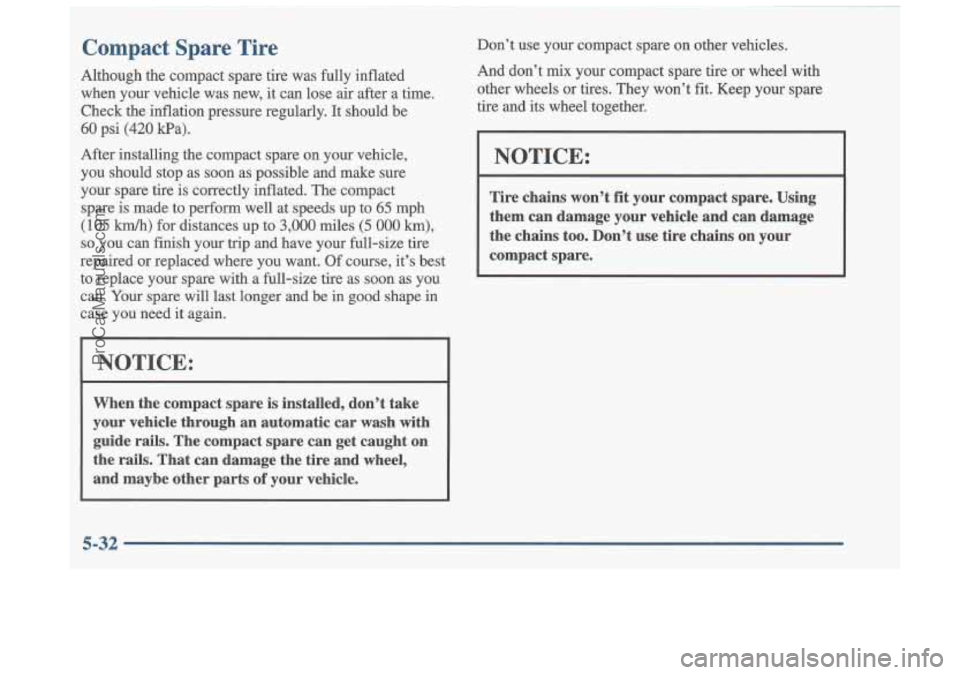
Compact Spare Tire
Although the compact spare tire was fully inflated
when your vehicle was new,
it can lose air after a time.
Check the inflation pressure regularly. It should be
60 psi (420 Wa).
After installing the compact spare on your vehicle,
you should stop as soon as possible and make sure
your spare tire is correctly inflated. The compact
spare is made to perform well at speeds up to
65 mph
(105 km/h) for distances up to 3,000 miles (5 000 lun),
so you can finish your trip and have your full-size tire
repaired or replaced where you want. Of course, it’s best
to replace your spare with a full-size tire as soon
as you
can.
Your spare will last longer and be in good shape in
case you need it again.
NOTICE:
When the compact spare is installed, don’t take
your vehicle through an automatic car wash with
guide rails. The compact spare can get caught on
the rails. That can damage the tire and wheel,
and maybe other parts
of your vehicle. Don’t use your compact spare on other vehicles.
And don’t
mix your compact spare tire or wheel with
other wheels or tires. They won’t fit. Keep your spare
tire and its wheel together.
NOTICE:
Tire chains won’t fit your compact spare. Using
them can damage your vehicle and can damage
the chains too. Don’t use tire chains on your
compact spare.
5-32
ProCarManuals.com
Page 220 of 353
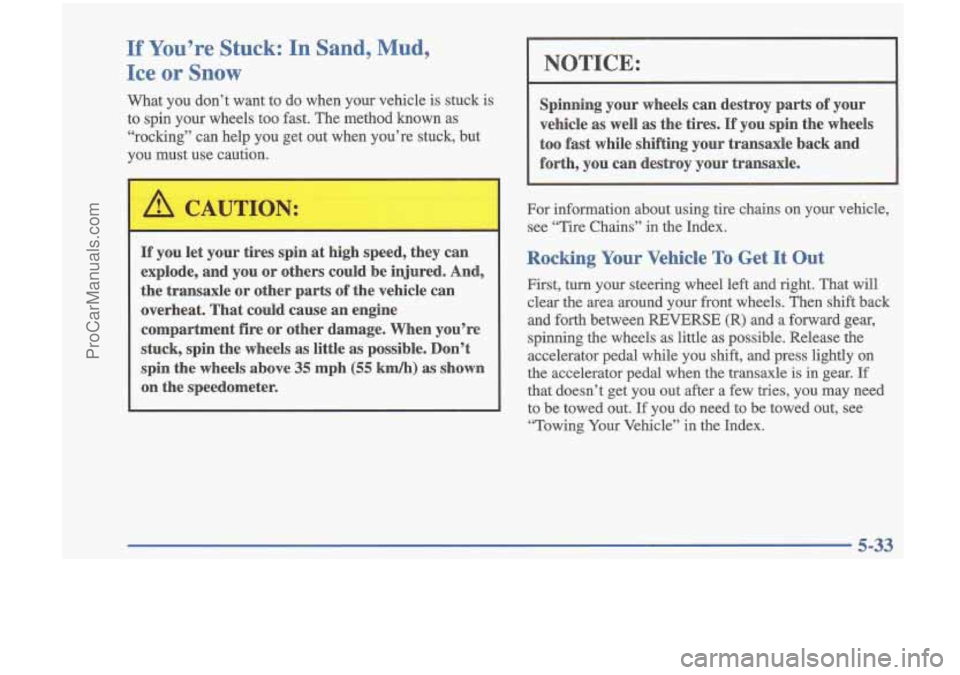
If You’re Stuck: In Sand, Mud,
Ice
or Snow
What you don’t want to do when your vehicle is stuck is
to
spin your wheels too fast. The method known as
“rocking” can help you get out when you’re stuck, but \
you
must use caution.
~ ~~ ~
If you let your tires spin at high speed, they can
explode, and you or others could be injured. And,
the transaxle or other parts of the vehicle can
overheat. That could cause an engine
compartment fire or other damage. When you’re
stuck, spin the wheels as little as possible. Don’t
spin the wheels above
35 mph (55 km/h) as shown
on the speedometer.
NOTICE:
Spinning your wheels can destroy parts of your
vehicle as well as the tires.
If you spin the wheels
too fast whiIe shifting your transaxle back and
forth, you can destroy your transaxle.
For information about using tire chains on your vehicle,
see “Tire Chains” in the Index.
Rocking Your Vehicle To Get It Out
First, turn your steering wheel left and right. That will
clear the area around your front wheels. Then shift back
and forth between REVERSE
(R) and a forward gear,
spinning the wheels as little as possible. Release the
accelerator pedal while you shift, and press lightly
on
the accelerator pedal when the transaxle is in gear. If
that doesn’t get you out after a few tries, you may need
to be towed out. If you do need to be towed out, see
“Towing Your Vehicle” in the Index.
5-33
ProCarManuals.com
Trending: keyless, fuel, seats, audio, coolant reservoir, battery replacement, oil dipstick
